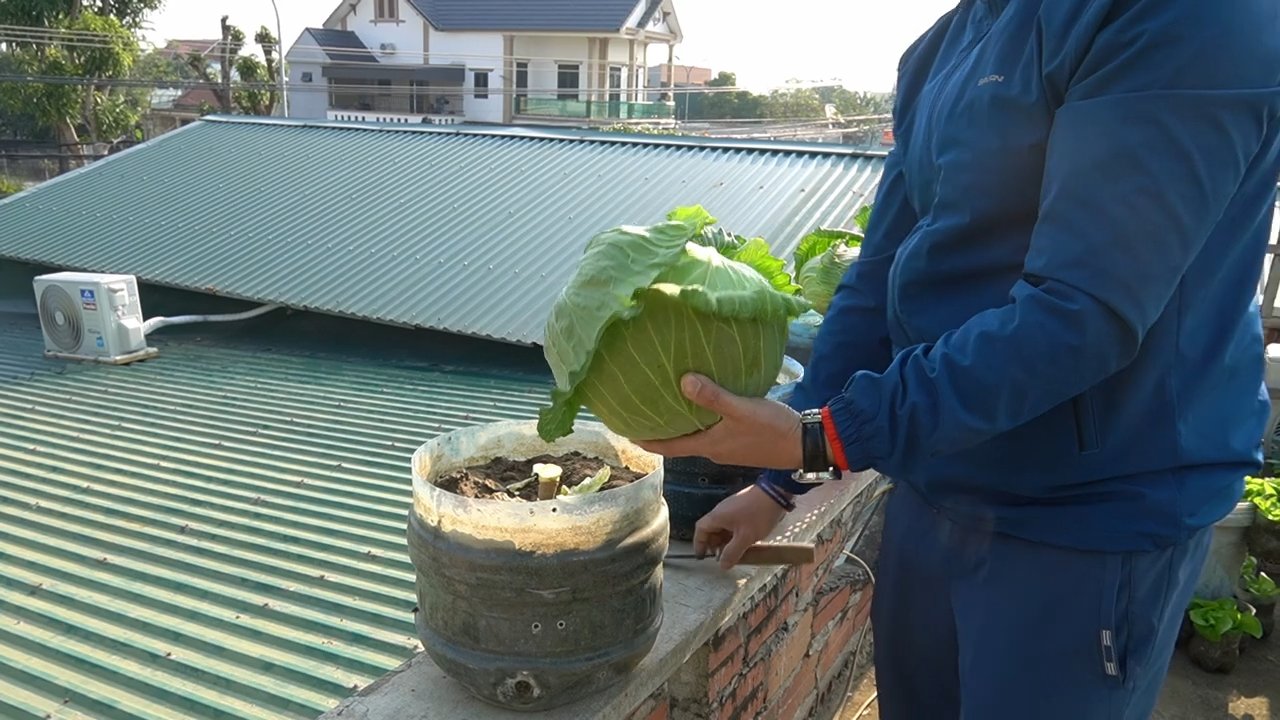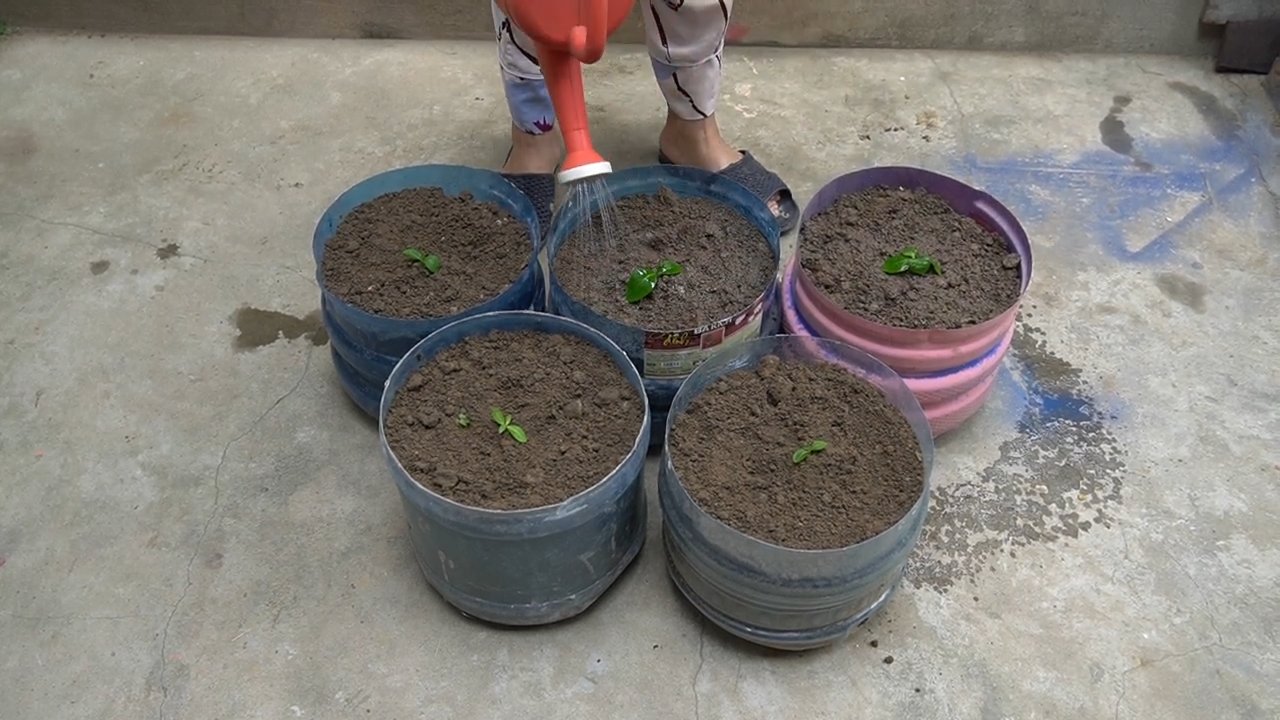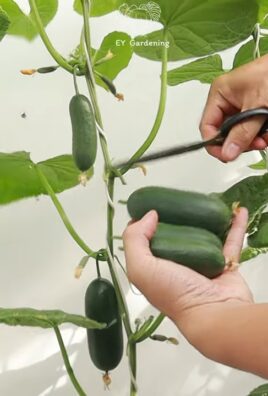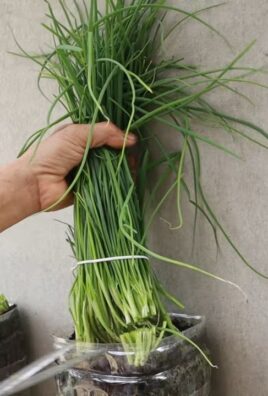Growing Cabbage in Plastic Bottles might sound a little unconventional, right? But trust me, this ingenious DIY trick is a game-changer for home gardeners, especially those with limited space or challenging soil conditions. For centuries, cabbage has been a staple in diets around the world, from the hearty stews of Eastern Europe to the vibrant slaws of Asia. Its cultivation dates back to ancient times, and now, we’re bringing this time-honored vegetable into the modern age with a sustainable twist!
Have you ever struggled with pests munching on your precious cabbage seedlings, or battled with poor drainage in your garden? I know I have! That’s where this clever hack comes in. Growing cabbage in plastic bottles offers a protective barrier against common garden pests like slugs and snails, and it allows for better control over soil quality and moisture levels. Plus, it’s a fantastic way to recycle those plastic bottles that might otherwise end up in a landfill.
This DIY project is perfect for urban gardeners, apartment dwellers with balconies, or anyone looking for a creative and eco-friendly way to enjoy fresh, homegrown cabbage. I’m excited to share this simple yet effective method with you, so you can experience the joy of harvesting your own delicious cabbage, even in the most unexpected of places. Let’s get started and transform those plastic bottles into mini cabbage paradises!

Growing Cabbage in Plastic Bottles: A DIY Guide
Hey there, fellow gardening enthusiasts! Ever thought about growing cabbage in plastic bottles? It might sound a little crazy, but trust me, it’s a fantastic way to save space, recycle, and enjoy fresh, homegrown cabbage. I’ve been experimenting with this method for a while now, and I’m excited to share my tips and tricks with you. Let’s dive in!
Why Grow Cabbage in Plastic Bottles?
Before we get started, you might be wondering why you’d even want to grow cabbage in plastic bottles. Here’s the lowdown:
* Space Saving: Perfect for small gardens, balconies, or even indoor growing.
* Recycling: Gives those plastic bottles a new lease on life.
* Pest Control: Easier to monitor and protect your plants from pests.
* Portability: You can easily move your cabbage plants around to find the best sunlight.
* Unique Aesthetic: Adds a quirky and fun touch to your garden.
Materials You’ll Need
Okay, let’s gather our supplies. Here’s what you’ll need to get started:
* Plastic Bottles: 2-liter soda bottles or larger water bottles work best. The more, the merrier!
* Cabbage Seeds or Seedlings: Choose your favorite cabbage variety. I personally love ‘Golden Acre’ for its compact size.
* Potting Mix: A well-draining potting mix is crucial.
* Scissors or a Utility Knife: For cutting the plastic bottles.
* Drill or Nail: To create drainage holes.
* Watering Can or Hose: For watering your cabbage plants.
* Fertilizer: A balanced fertilizer to feed your cabbage.
* Optional: Twine or wire for hanging the bottles (if you want to create a vertical garden).
Preparing the Plastic Bottles
This is where we transform those empty bottles into cozy homes for our cabbage plants.
1. Clean the Bottles: Thoroughly wash the plastic bottles with soap and water to remove any residue. Rinse them well and let them dry completely.
2. Cut the Bottles: There are a couple of ways you can cut the bottles, depending on how you want to grow your cabbage.
* Option 1: Vertical Planters: Cut the bottle in half horizontally. You’ll use the bottom half as the planter. The top half can be discarded or used as a mini-greenhouse cover for seedlings.
* Option 2: Hanging Planters: Cut a rectangular opening on one side of the bottle, leaving the top and bottom intact. This will create a “window” for your cabbage to grow out of.
3. Create Drainage Holes: This is super important! Cabbage doesn’t like soggy roots. Use a drill or a nail to create several drainage holes in the bottom of the bottle. If you’re using the hanging planter method, make sure to create drainage holes on the bottom side of the bottle.
4. Optional: Hanging Mechanism: If you’re going for a hanging garden, now’s the time to create the hanging mechanism. Drill two holes on either side of the bottle near the top. Thread twine or wire through the holes to create a loop for hanging.
Planting Your Cabbage
Now for the fun part – planting our cabbage!
1. Fill the Bottles with Potting Mix: Fill the prepared plastic bottles with a good quality potting mix. Leave about an inch of space at the top.
2. Plant the Seeds or Seedlings:
* From Seeds: Sow the cabbage seeds about 1/4 inch deep in the potting mix. Gently water the soil.
* From Seedlings: Carefully remove the cabbage seedlings from their containers. Create a small hole in the potting mix and gently place the seedling in the hole. Backfill with potting mix and gently water.
3. Water Thoroughly: After planting, water the soil thoroughly until water drains out of the drainage holes.
Caring for Your Cabbage Plants
Cabbage needs a little TLC to thrive. Here’s how to keep your plants happy and healthy:
1. Sunlight: Cabbage needs at least 6 hours of sunlight per day. Place your plastic bottle planters in a sunny location. If you’re growing indoors, consider using grow lights.
2. Watering: Water regularly, especially during hot weather. The soil should be consistently moist, but not waterlogged. Check the soil moisture by sticking your finger into the soil. If the top inch feels dry, it’s time to water.
3. Fertilizing: Feed your cabbage plants with a balanced fertilizer every 2-3 weeks. Follow the instructions on the fertilizer package. I like to use a liquid fertilizer diluted in water.
4. Pest Control: Keep an eye out for pests like cabbage worms, aphids, and slugs. Handpick any pests you see. You can also use organic pest control methods like neem oil or insecticidal soap.
5. Weeding: Remove any weeds that may grow in the plastic bottles. Weeds can compete with your cabbage plants for nutrients and water.
6. Rotating: If you’re growing in a small space, rotate your plastic bottle planters regularly to ensure that all sides of the plants receive adequate sunlight.
Harvesting Your Cabbage
The moment we’ve all been waiting for – harvesting!
1. Check for Maturity: Cabbage is usually ready to harvest when the head is firm and compact. The size of the head will vary depending on the variety.
2. Harvesting: Use a sharp knife to cut the cabbage head from the stem. Leave a few outer leaves on the stem, as they may produce smaller side heads.
3. Enjoy Your Harvest: Enjoy your homegrown cabbage in salads, soups, stews, or any other dish you like!
Troubleshooting
Sometimes things don’t go exactly as planned. Here are a few common problems you might encounter and how to fix them:
* Yellowing Leaves: This could be a sign of overwatering, underwatering, or nutrient deficiency. Check the soil moisture and adjust your watering accordingly. Fertilize your plants if they are lacking nutrients.
* Slow Growth: This could be due to lack of sunlight, poor soil, or pests. Make sure your plants are getting enough sunlight and that the soil is well-draining and nutrient-rich. Check for pests and take appropriate action.
* Bolting: Bolting is when the cabbage plant starts to produce flowers prematurely. This is usually caused by stress, such as hot weather or inconsistent watering. Try to provide consistent watering and protect your plants from extreme temperatures.
* Pest Infestation: As mentioned earlier, keep an eye out for pests and take action as soon as you see them.
Tips for Success
Here are a few extra tips to help you succeed with growing cabbage in plastic bottles:
* Choose the Right Variety: Select a cabbage variety that is well-suited for container gardening. Compact varieties like ‘Golden Acre’ are a good choice.
* Use High-Quality Potting Mix: A good quality potting mix is essential for healthy cabbage growth. Avoid using garden soil, as it can be too heavy and may not drain well.
* Don’t Overcrowd: Give your cabbage plants enough space to grow. If you’re planting multiple plants in one bottle, make sure they are spaced far enough apart.
* Monitor Regularly: Check your plants regularly for signs of pests, diseases, or nutrient deficiencies. The sooner you catch a problem, the easier it will be to fix.
* Have Fun! Gardening should be enjoyable. Don’t be afraid to experiment and try new things.
Advanced Techniques
Want to take your plastic bottle cabbage gardening to the next level? Here are a few advanced techniques to try:
* Vertical Gardening: Create a stunning vertical garden by hanging multiple plastic bottle planters on a wall or fence.
* Hydroponics: Grow your cabbage hydroponically in plastic bottles. This involves growing plants without soil, using a nutrient-rich water solution.
* Companion Planting: Plant companion plants like marigolds or nasturtiums near your cabbage to deter pests.
* Succession Planting: Plant new cabbage seeds or seedlings every few weeks to ensure a continuous harvest.
Growing cabbage in plastic bottles is a rewarding and sustainable way to enjoy fresh, homegrown produce. With a little bit of effort and these tips, you’ll be harvesting delicious cabbage in no time! Happy gardening!

Conclusion
So, there you have it! Growing cabbage in plastic bottles isn’t just a quirky gardening experiment; it’s a genuinely effective method for maximizing space, protecting your precious plants, and enjoying a bountiful harvest, even in limited areas. We’ve explored how this simple DIY trick can transform your gardening experience, offering a solution to common challenges like pest control, soil erosion, and space constraints.
The beauty of this method lies in its adaptability. Feel free to experiment with different sizes of plastic bottles to accommodate various cabbage varieties. Consider painting the bottles white or covering them with reflective material to further protect the roots from excessive heat, especially in warmer climates. You can also explore different soil mixtures to find what works best for your specific cabbage type and local conditions. Perhaps try adding some slow-release fertilizer to the soil mix for an extra boost of nutrients.
Beyond the practical benefits, growing cabbage in plastic bottles is also incredibly rewarding. Watching your tiny seedlings thrive within their recycled containers, gradually transforming into robust, leafy cabbages, is a testament to the power of resourcefulness and sustainable gardening practices. It’s a fantastic way to involve children in the gardening process, teaching them about plant life cycles, recycling, and the importance of growing your own food.
This method is particularly beneficial for those who live in apartments, have small balconies, or simply want to make the most of their available gardening space. It’s also an excellent option for gardeners who struggle with pests like cabbage white butterflies or slugs, as the bottles provide a physical barrier, making it harder for these critters to reach your plants.
Remember, the key to success with this DIY trick is to provide your cabbage plants with the right conditions: plenty of sunlight, well-draining soil, and consistent watering. Don’t be afraid to adjust your approach based on your local climate and the specific needs of your cabbage variety.
We wholeheartedly encourage you to give growing cabbage in plastic bottles a try. It’s a fun, affordable, and environmentally friendly way to enjoy fresh, homegrown cabbage. Once you’ve experienced the satisfaction of harvesting your own cabbages from recycled containers, you’ll be hooked!
Don’t forget to share your experiences with us! We’d love to hear about your successes, challenges, and any variations you’ve tried. Post photos of your cabbage-filled plastic bottles on social media using #CabbageInBottles and inspire others to embrace this innovative gardening technique. Let’s create a community of resourceful gardeners who are passionate about growing their own food in a sustainable and creative way. Happy gardening!
Frequently Asked Questions (FAQ)
What type of plastic bottles are best for growing cabbage?
Ideally, you should use food-grade plastic bottles, such as those that previously contained water, juice, or soda. Avoid using bottles that held chemicals or other potentially harmful substances. The size of the bottle will depend on the variety of cabbage you’re growing. Smaller varieties can thrive in 2-liter bottles, while larger varieties may require 3-liter or even larger containers. Make sure the bottles are clean and free of any residue before planting.
How do I prepare the plastic bottles for planting?
First, thoroughly clean the bottles with soap and water to remove any dirt or residue. Then, cut off the top portion of the bottle, leaving enough space for the cabbage plant to grow. Drill or poke several drainage holes in the bottom of the bottle to prevent waterlogging. You can also add a layer of gravel or small stones to the bottom of the bottle to further improve drainage.
What type of soil should I use for growing cabbage in plastic bottles?
Cabbage plants prefer well-draining, fertile soil that is rich in organic matter. A good potting mix specifically designed for vegetables is an excellent choice. You can also create your own soil mix by combining equal parts of garden soil, compost, and perlite or vermiculite. This will provide your cabbage plants with the nutrients they need to thrive while ensuring proper drainage.
How often should I water my cabbage plants grown in plastic bottles?
Water your cabbage plants regularly, especially during hot and dry weather. The soil should be kept consistently moist but not waterlogged. Check the soil moisture level by sticking your finger into the soil. If the top inch feels dry, it’s time to water. Avoid overwatering, as this can lead to root rot.
How much sunlight do cabbage plants need?
Cabbage plants need at least 6 hours of direct sunlight per day to thrive. Choose a sunny location for your plastic bottle garden. If you live in a particularly hot climate, you may need to provide some afternoon shade to prevent the plants from overheating.
How do I protect my cabbage plants from pests and diseases?
Growing cabbage in plastic bottles can help to deter some pests, such as cabbage white butterflies and slugs. However, you may still need to take additional measures to protect your plants. Regularly inspect your plants for signs of pests or diseases. If you notice any problems, treat them promptly with an appropriate organic pesticide or fungicide. You can also use netting or row covers to protect your plants from pests.
Can I grow different varieties of cabbage in plastic bottles?
Yes, you can grow different varieties of cabbage in plastic bottles. Consider the size of the mature cabbage head when choosing a variety. Smaller varieties, such as bok choy or napa cabbage, are well-suited for smaller bottles, while larger varieties, such as green cabbage or red cabbage, may require larger containers.
How do I fertilize my cabbage plants grown in plastic bottles?
Cabbage plants are heavy feeders and require regular fertilization. Use a balanced fertilizer specifically designed for vegetables. Follow the instructions on the fertilizer package for application rates. You can also add compost or other organic matter to the soil to provide your plants with additional nutrients.
When is the best time to harvest my cabbage?
The harvesting time will depend on the variety of cabbage you’re growing. Generally, cabbage is ready to harvest when the head is firm and compact. Check the seed packet or plant tag for specific harvesting instructions. To harvest, simply cut the cabbage head from the stem with a sharp knife.
Can I reuse the plastic bottles for future plantings?
Yes, you can reuse the plastic bottles for future plantings. However, it’s important to thoroughly clean and disinfect the bottles before reusing them to prevent the spread of diseases. Wash the bottles with soap and water, and then soak them in a solution of 1 part bleach to 9 parts water for 30 minutes. Rinse the bottles thoroughly before using them again.
What are the benefits of growing cabbage in plastic bottles compared to traditional gardening methods?
Growing cabbage in plastic bottles offers several advantages:
* **Space-saving:** Ideal for small gardens, balconies, or patios.
* **Pest control:** The bottles provide a physical barrier against some pests.
* **Soil control:** Allows you to use specific soil mixes tailored to cabbage.
* **Portability:** Easy to move plants to optimal sunlight or shelter.
* **Recycling:** A sustainable way to reuse plastic bottles.
* **Reduced weeding:** Less soil surface exposed, reducing weed growth.
Is growing cabbage in plastic bottles suitable for all climates?
While growing cabbage in plastic bottles can be adapted to various climates, it’s essential to consider the specific needs of cabbage plants. In hotter climates, providing shade during the hottest part of the day is crucial to prevent overheating. In colder climates, you may need to provide additional protection from frost. Choose cabbage varieties that are well-suited to your local climate for best results.




Leave a Comment